|
Korathota Raja Maha Vihara:
Oldest and longest cave inscriptions
By Janani AMARASEKARA
This stone inscription is proof to say that
2500 years ago, a king ruled this area. According to Senarath
Paranavithane, it belongs to between the third century B.C. to second
century B.C.
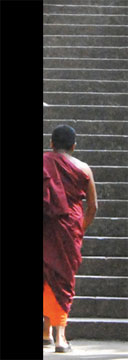 |
|
The long flight of
steps |
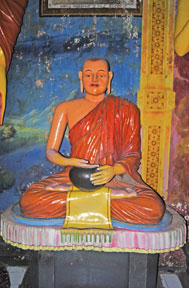 |
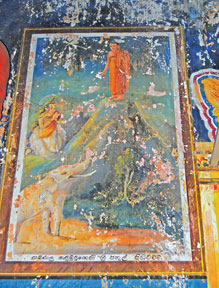 |
|
Inside the Viharage |
Turning off the old Colombo-Ratnapura Road, from Kaduwela heading
towards Homagama, a few minutes’ drive brings us to Korathota Raja Maha
Vihara, an ancient temple that radiates its splendour amongst the
quarries in Kaduwela. This temple, which dates back to 2000 years, is
one of the few ancient temples found in the Western Province, sited on
the top of a mountain next to the Belungala Rock in Kaduwela. This
temple boasts of having the oldest and longest cave inscriptions in the
Colombo district. In addition to the historic artefacts, the ‘show off
peacock’ and the ‘white porcupine’ add extra colour to the place.
The historic caves
The history of the temple runs to the era of King Valagamba and King
Mahathissa. The historic cave inscriptions and the six caves are the
focal points of the temple. The caves give a hint of the good times of
this place. After climbing a long flight of steps, devotees are welcomed
by a Sandakadapahana or a moonstone, which has carved motifs of tuskers,
lions, horses and bulls in one arc and the other arcs with motifs like
Liyavela and flower petals Palapethi. After the moonstone, the path
leads us to the caves with Kataram carving, something that is carved on
the top of the overhanging rock to prevent water dripping into the cave.
Among the caves at the temple, the largest cave is 25 metres in length,
15 metres in width and 18 metres in height. This cave houses a recently
built Vihara Geya. A large statue of the reclining Buddha, five large
standing Buddha statues and two smaller ones can be seen inside.
However, these do not have a significant archaeological value as those
have been reconstructed after the Kandy era. There are also some murals
and two devalas in it. To the right of the cave temple is a smaller cave
with the Chetiya in front.
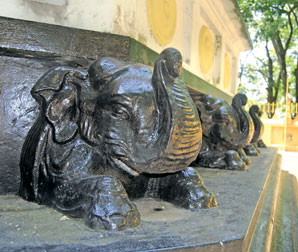 |
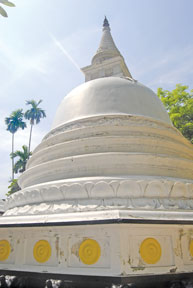 |
|
The decorations around
the pagoda |
Towards the left of the Viharage, there is
another cave, which is 16 meters long, 10 metres wide and 22 metres
high. This is used as the Pattini Devalaya now. There is a smaller cave
towards the left from this cave, which is 12 feet long, 8 feet wide and
8 feet high. The overhung rock of this cave has a stone inscription
belonging to the third century B.C. The smallest cave lies further away
from these caves in front of the bo-tree. The last cave is located about
350 metres north of the Viharage. It is at the extreme west of the
temple premises. The way to the cave is rough and steep.
The entrance naturally hewn into the rock is almost covered with a
thick growth of foliage. This would have resembled the original
environment of the caves. Here, one could imagine the monks of yore,
meditating, performing their religious rites and living their simple
lives in these forest caves, with only the rustling of leaves and the
call of birds to disturb them.
The tunnel inside the third cave and behind the reclining Buddha
statue there are entrances to a tunnel, which is said to be leading to
the Kelaniya temple. Legend also states that this leads to the
Kaduwakkalama via Kaduwela Rankadu Devalaya. It is said that a
Portuguese slave lived in the cave. However, according to a resident
bhikkhu of the temple, the legend mentions about a gold plate in the
middle of this tunnel. “Some people, who were greedy for gold, went in
search of it, but never returned. It is believed that they must have
perished due to the lack of Oxygen inside the tunnel. So, now, the
tunnel is sealed,” he added.
The longest cave inscription
The cave inscription, is considered as the longest and oldest
inscription found in the Colombo district, can be seen near one of these
Kataram carvings above the cave next to the Viharage. This inscription
is written in Brahmi lettering. This states about a cave donated by the
daughter of the King, ‘Mahabi’, and another cave named ‘Manapadassana’
donated by the son of ‘Parumuka Sumana’, ‘Sumana’.
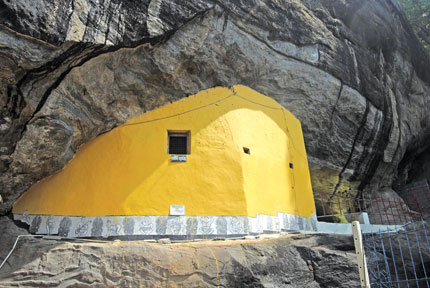 |
|
Kataram of the cave
temple |
It is proof to say that 2500 years ago, a king ruled this area.
According to Senarath Paranavithane, this stone inscription belongs
between the third century B.C. to second century B.C. However,
inscriptions talk about an anonymous king, who remains a mystery
to-date. It is said that the person known as Sumana is Velusumana - one
of the 10 great giants of King Dutugemunu.
“According to legend, during the Anuradhapura era, Viharamaha Devi,
the daughter of King Kelanithissa and Sumana had attended a pooja at the
Korathota temple. Later Sumana had become popular as Velusumana, because
he had risked his life to bring some bees' honey from Anuradhapura to
fulfil a pregnancy craving of the queen,” explained Habarakada
Sumanasara Thera.
According to historians and archaeologists, Korathota Raja Maha
Vihara had owned more than 3000 acres of land, which encompassed several
tanks and a prosperous paddy cultivation. Apart from ancient artefacts,
there are many animals roaming freely in the temple premises.
The peacock at the temple opens its decorative feathers very often.
“When there is a crowd, it opens its feathers and shows off,” said the
resident bhikkkhu.
The white porcupine is another attraction of the temple. In addition
to these animals, there are deer, ducks, hens, turkey, and lovebirds.
Korathota Raja Maha Vihara is one of the treasures of the country. It
must be protected for posterity.
Though the caves are preserved with care, other parts of the temple
are somewhat commercialised. With shops here and there, we were a bit
confused at first whether we arrived at the correct temple. The area
where the cave temples are situated is closed during the day and it is
opened only around 2 pm.
|

